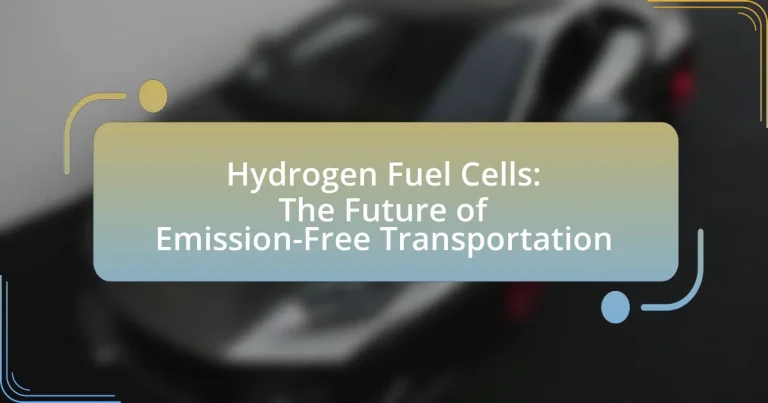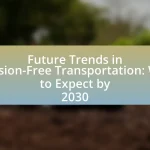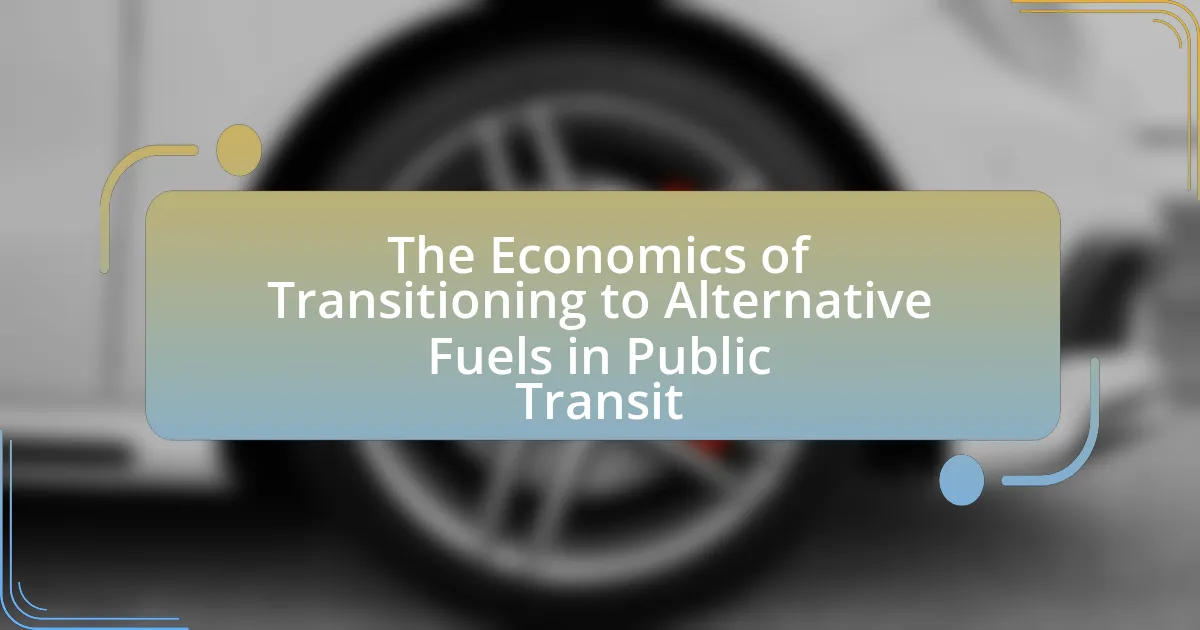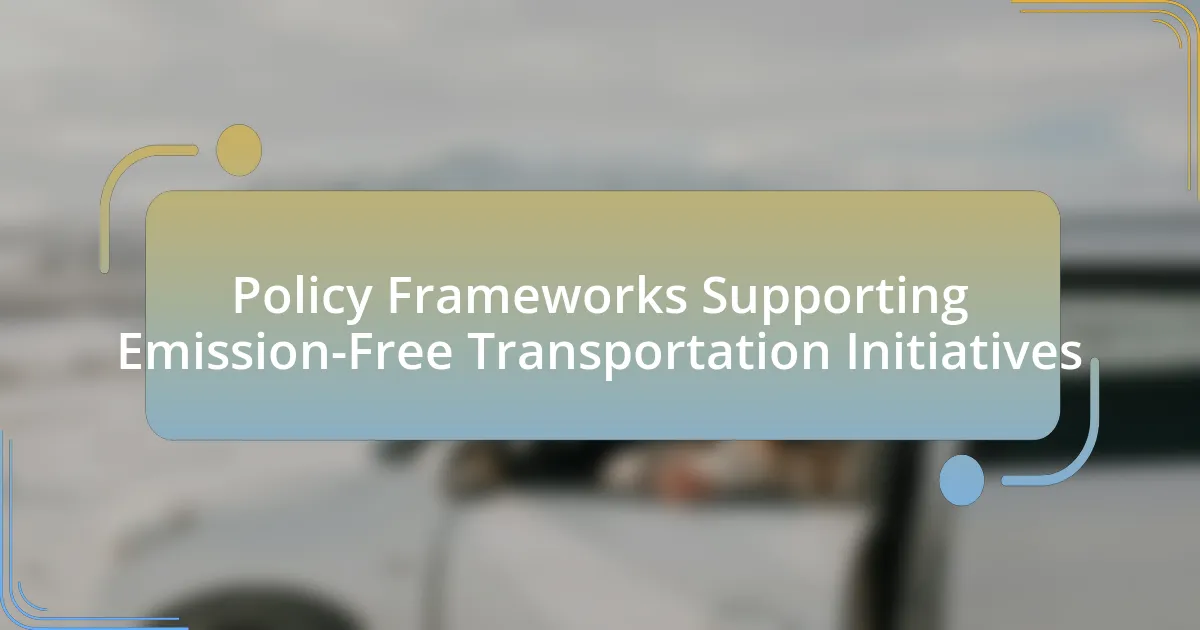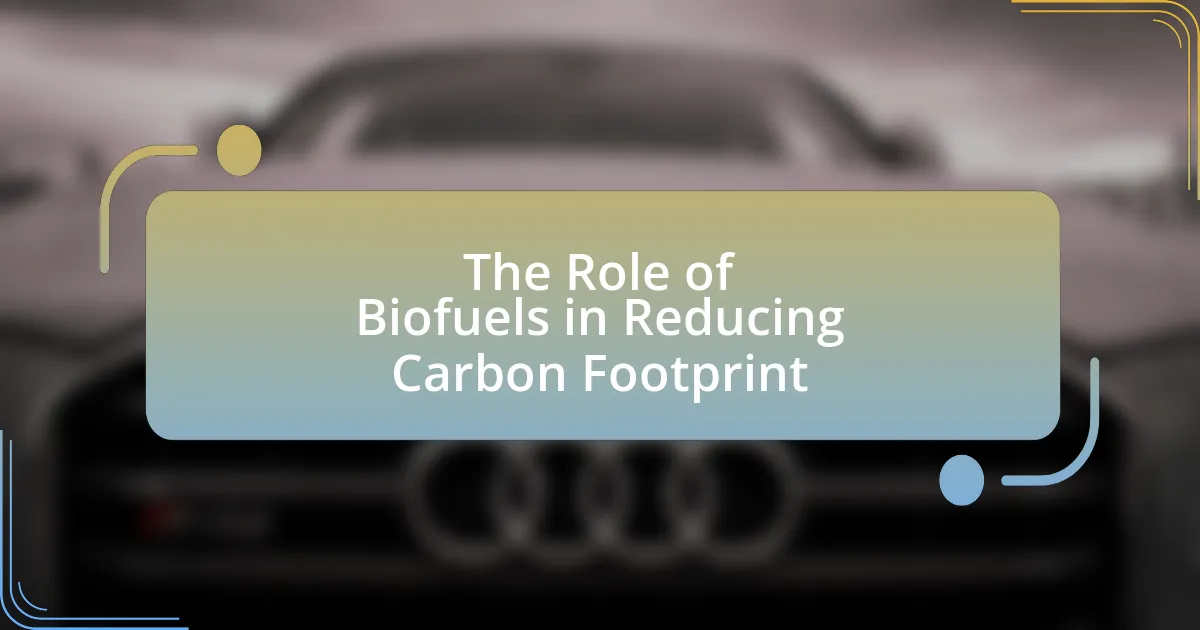Hydrogen fuel cells are devices that convert chemical energy from hydrogen into electrical energy through an electrochemical reaction, producing only water vapor as a byproduct. This technology is recognized for its high efficiency, achieving up to 60%, and its potential to contribute to emission-free transportation. The article explores the operational mechanisms of hydrogen fuel cells, their key components, advantages, and the challenges they face, including high production costs and limited infrastructure. It also discusses the economic benefits, safety concerns, and the role of policy in supporting hydrogen fuel cell adoption, while highlighting advancements and future prospects in the sector.

What are Hydrogen Fuel Cells?
Hydrogen fuel cells are devices that convert chemical energy from hydrogen into electrical energy through an electrochemical reaction. This process involves hydrogen gas reacting with oxygen from the air, producing electricity, water, and heat as byproducts. Hydrogen fuel cells are recognized for their efficiency and low emissions, making them a promising technology for emission-free transportation. According to the U.S. Department of Energy, hydrogen fuel cells can achieve efficiencies of up to 60%, significantly higher than traditional combustion engines.
How do Hydrogen Fuel Cells operate?
Hydrogen fuel cells operate by converting chemical energy from hydrogen and oxygen into electrical energy through an electrochemical reaction. In this process, hydrogen gas is supplied to the anode, where it is split into protons and electrons. The protons pass through a proton exchange membrane to the cathode, while the electrons travel through an external circuit, generating electricity. At the cathode, oxygen from the air combines with the protons and electrons to produce water and heat as byproducts. This mechanism allows hydrogen fuel cells to generate electricity efficiently, with water being the only emission, supporting their role in emission-free transportation.
What are the key components of a Hydrogen Fuel Cell?
The key components of a hydrogen fuel cell are the anode, cathode, electrolyte, and external circuit. The anode is where hydrogen gas is supplied and split into protons and electrons. The electrolyte allows only protons to pass through while blocking electrons, which travel through the external circuit, generating electricity. The cathode is where oxygen is introduced, and it combines with the protons and electrons to produce water and heat as byproducts. These components work together to convert chemical energy from hydrogen into electrical energy efficiently, making hydrogen fuel cells a promising technology for emission-free transportation.
How does the electrochemical process in Hydrogen Fuel Cells work?
The electrochemical process in hydrogen fuel cells generates electricity through the reaction of hydrogen and oxygen. In this process, hydrogen gas is supplied to the anode, where it is split into protons and electrons by a catalyst. The protons pass through the electrolyte membrane to the cathode, while the electrons travel through an external circuit, creating an electric current. At the cathode, oxygen from the air combines with the protons and electrons to form water, which is the only byproduct of this reaction. This efficient conversion of chemical energy into electrical energy is fundamental to the operation of hydrogen fuel cells, making them a clean energy source for transportation.
What are the advantages of using Hydrogen Fuel Cells?
Hydrogen fuel cells offer several advantages, including high efficiency, zero emissions, and rapid refueling capabilities. The efficiency of hydrogen fuel cells can reach up to 60%, significantly higher than traditional internal combustion engines, which typically operate at around 20-30% efficiency. Additionally, hydrogen fuel cells emit only water vapor as a byproduct, making them an environmentally friendly alternative to fossil fuels. The refueling process for hydrogen vehicles takes approximately 3 to 5 minutes, comparable to gasoline vehicles, which enhances their practicality for consumers. These benefits position hydrogen fuel cells as a promising solution for sustainable transportation.
How do Hydrogen Fuel Cells contribute to emission-free transportation?
Hydrogen fuel cells contribute to emission-free transportation by converting hydrogen and oxygen into electricity, with water vapor as the only byproduct. This process eliminates harmful emissions such as carbon dioxide and nitrogen oxides, which are prevalent in traditional combustion engines. According to the U.S. Department of Energy, hydrogen fuel cells can achieve efficiencies of up to 60%, significantly reducing the environmental impact of transportation compared to fossil fuel-powered vehicles.
What are the economic benefits of Hydrogen Fuel Cells in the transportation sector?
Hydrogen fuel cells provide significant economic benefits in the transportation sector by reducing dependency on fossil fuels and lowering operational costs. These fuel cells convert hydrogen into electricity, which can power vehicles with minimal emissions, leading to potential savings in fuel costs and maintenance. For instance, hydrogen fuel cell vehicles can achieve a range comparable to traditional gasoline vehicles while offering lower energy costs per mile. Additionally, the hydrogen economy can stimulate job creation in manufacturing, distribution, and infrastructure development, with the International Renewable Energy Agency estimating that transitioning to hydrogen could create millions of jobs globally by 2030. Furthermore, investments in hydrogen infrastructure can enhance energy security and stabilize energy prices, contributing to a more resilient economy.

What challenges do Hydrogen Fuel Cells face?
Hydrogen fuel cells face several significant challenges, including high production costs, limited infrastructure, and efficiency issues. The production of hydrogen, primarily through methods like steam methane reforming, is expensive and energy-intensive, making it less economically viable compared to other energy sources. Additionally, the lack of widespread refueling infrastructure limits the adoption of hydrogen fuel cell vehicles, as consumers are hesitant to invest in technology that lacks convenient access to refueling stations. Furthermore, hydrogen fuel cells typically have lower overall efficiency compared to battery electric vehicles, which can hinder their competitiveness in the growing market for emission-free transportation.
What are the current limitations of Hydrogen Fuel Cell technology?
The current limitations of Hydrogen Fuel Cell technology include high production costs, limited infrastructure, and challenges in hydrogen storage and distribution. High production costs stem from the expensive materials used in fuel cells, such as platinum, which can make them less economically viable compared to other energy sources. Limited infrastructure is evident in the scarcity of hydrogen refueling stations, which restricts the widespread adoption of hydrogen-powered vehicles. Additionally, hydrogen storage poses challenges due to its low energy density and the need for high-pressure tanks or cryogenic storage, complicating transportation and usage. These factors collectively hinder the broader implementation of hydrogen fuel cells in the transportation sector.
How does the infrastructure for Hydrogen Fuel Cells impact their adoption?
The infrastructure for hydrogen fuel cells significantly impacts their adoption by determining the availability and accessibility of refueling stations. A well-developed network of hydrogen refueling stations enhances consumer confidence and convenience, which is crucial for the widespread use of hydrogen-powered vehicles. For instance, as of 2023, countries like Japan and Germany have invested heavily in hydrogen infrastructure, resulting in a higher number of refueling stations per capita compared to regions with limited infrastructure, such as the United States. This disparity illustrates that robust infrastructure directly correlates with increased adoption rates of hydrogen fuel cell technology, as evidenced by the growing number of hydrogen vehicles on the roads in regions with comprehensive refueling networks.
What safety concerns are associated with Hydrogen Fuel Cells?
Hydrogen fuel cells pose several safety concerns primarily related to hydrogen’s flammability and storage. Hydrogen is highly flammable and can form explosive mixtures with air, which raises risks during leaks or accidents. According to the U.S. Department of Energy, hydrogen has a lower ignition energy than gasoline, making it easier to ignite. Additionally, the storage of hydrogen under high pressure presents risks of rupture or explosion if not properly managed. The National Renewable Energy Laboratory highlights that safety measures, such as proper ventilation and leak detection systems, are essential to mitigate these risks.
How can these challenges be addressed?
To address the challenges of hydrogen fuel cells in emission-free transportation, advancements in production, storage, and infrastructure are essential. Improving electrolysis technology can enhance hydrogen production efficiency, making it more cost-effective and sustainable. For instance, research indicates that using renewable energy sources for electrolysis can reduce production costs significantly, with studies showing potential reductions of up to 50% by 2030. Additionally, developing robust storage solutions, such as high-pressure tanks and metal hydrides, can mitigate safety concerns and improve transport logistics. Furthermore, expanding hydrogen refueling infrastructure is crucial; a report from the Hydrogen Council states that increasing the number of refueling stations can lead to a 30% increase in fuel cell vehicle adoption. These combined efforts can effectively tackle the current challenges faced by hydrogen fuel cells in the transportation sector.
What advancements are being made to improve Hydrogen Fuel Cell technology?
Advancements in Hydrogen Fuel Cell technology include the development of more efficient catalysts, improved membrane materials, and enhanced storage solutions. Researchers are focusing on platinum-free catalysts to reduce costs and increase efficiency, with studies showing that non-precious metal catalysts can achieve comparable performance. Additionally, advancements in proton exchange membranes, such as those made from advanced polymers, are enhancing durability and performance under varying conditions. Furthermore, innovations in hydrogen storage, including solid-state and liquid organic hydrogen carriers, are addressing safety and capacity challenges, making hydrogen fuel cells more viable for widespread use in transportation.
How can policy changes support the growth of Hydrogen Fuel Cells?
Policy changes can support the growth of hydrogen fuel cells by providing financial incentives, regulatory frameworks, and infrastructure development. Financial incentives, such as tax credits and subsidies, can lower the cost of hydrogen production and fuel cell technology, making them more competitive with fossil fuels. Regulatory frameworks that mandate emissions reductions can create a market demand for hydrogen fuel cells, encouraging investment and innovation. Additionally, government investment in infrastructure, such as hydrogen refueling stations, is essential for widespread adoption, as it addresses the current limitations in availability and accessibility. For instance, the European Union’s Hydrogen Strategy aims to scale up hydrogen production and infrastructure, targeting 1 million tons of renewable hydrogen production by 2024, which exemplifies how policy can drive growth in this sector.

What is the future of Hydrogen Fuel Cells in transportation?
The future of hydrogen fuel cells in transportation is promising, with significant advancements expected in efficiency, infrastructure, and adoption rates. As governments and industries focus on reducing carbon emissions, hydrogen fuel cells are increasingly recognized for their potential to provide clean energy solutions, particularly in heavy-duty vehicles and public transportation. According to the Hydrogen Council, the global hydrogen market could reach $2.5 trillion by 2050, driven by the growing demand for zero-emission vehicles. Additionally, major automotive manufacturers are investing heavily in hydrogen technology, with companies like Toyota and Hyundai already producing fuel cell vehicles. This trend indicates a shift towards hydrogen as a viable alternative to fossil fuels, supported by ongoing research and development aimed at improving fuel cell performance and reducing costs.
How are major industries adopting Hydrogen Fuel Cells?
Major industries are adopting hydrogen fuel cells by integrating them into transportation, power generation, and industrial processes. For instance, automotive manufacturers like Toyota and Hyundai have developed hydrogen fuel cell vehicles, demonstrating a commitment to zero-emission transportation. In the logistics sector, companies such as Amazon and Walmart are investing in hydrogen-powered forklifts and delivery trucks to reduce carbon footprints. Additionally, energy companies are exploring hydrogen fuel cells for backup power systems and grid stabilization, with projects like the Hydrogen Energy Supply Chain in Australia showcasing the potential for large-scale hydrogen production and utilization. These initiatives reflect a broader trend towards sustainable energy solutions, supported by government incentives and advancements in hydrogen production technology.
What role do automakers play in the development of Hydrogen Fuel Cell vehicles?
Automakers play a crucial role in the development of Hydrogen Fuel Cell vehicles by investing in research, engineering, and production processes that advance this technology. Major automotive companies, such as Toyota and Honda, have developed and commercialized hydrogen fuel cell models, demonstrating their commitment to creating viable alternatives to traditional fossil fuel vehicles. For instance, Toyota’s Mirai, launched in 2014, represents a significant step in hydrogen fuel cell technology, showcasing the automaker’s investment of over $1 billion in fuel cell development. Additionally, automakers collaborate with governments and energy companies to establish hydrogen infrastructure, which is essential for the widespread adoption of fuel cell vehicles. This collaborative effort is evidenced by partnerships aimed at expanding hydrogen refueling stations, thereby enhancing the practicality and appeal of hydrogen fuel cell technology in the automotive market.
How are public transportation systems integrating Hydrogen Fuel Cells?
Public transportation systems are integrating hydrogen fuel cells by deploying hydrogen-powered buses and trains to reduce greenhouse gas emissions. For instance, cities like Hamburg and London have introduced hydrogen fuel cell buses into their fleets, which emit only water vapor and heat as byproducts. Additionally, the Alstom Coradia iLint, the world’s first hydrogen fuel cell passenger train, has been operational in Germany since 2018, showcasing the viability of hydrogen technology in rail transport. These implementations demonstrate a significant shift towards sustainable public transport solutions, supported by investments and partnerships between governments and private companies focused on hydrogen infrastructure development.
What innovations are on the horizon for Hydrogen Fuel Cells?
Innovations on the horizon for hydrogen fuel cells include advancements in solid oxide fuel cells (SOFCs), improvements in hydrogen production methods such as electrolysis using renewable energy, and the development of more efficient fuel cell membranes. Solid oxide fuel cells are expected to enhance efficiency and reduce costs, while new electrolysis techniques aim to lower the energy required for hydrogen production, making it more sustainable. Additionally, research into advanced membranes, such as those using nanomaterials, promises to increase the performance and durability of fuel cells, facilitating broader adoption in transportation and other sectors. These innovations are supported by ongoing research initiatives and investments from both public and private sectors, indicating a strong commitment to advancing hydrogen fuel cell technology.
How might Hydrogen Fuel Cells evolve in the next decade?
Hydrogen fuel cells are expected to evolve significantly in the next decade, driven by advancements in technology, increased investment, and growing demand for clean energy solutions. Innovations in materials, such as the development of more efficient catalysts and membranes, will enhance the performance and reduce the costs of fuel cells. For instance, research indicates that using platinum alternatives can lower production costs while maintaining efficiency. Additionally, the expansion of hydrogen production methods, including green hydrogen generated from renewable sources, will support a more sustainable supply chain. The global market for hydrogen fuel cells is projected to grow, with estimates suggesting a compound annual growth rate of over 20% by 2030, reflecting the increasing adoption in sectors like transportation, stationary power, and industrial applications.
What emerging technologies could enhance Hydrogen Fuel Cell efficiency?
Emerging technologies that could enhance hydrogen fuel cell efficiency include advanced catalysts, membrane technology, and hydrogen production methods. Advanced catalysts, such as those using platinum group metals or novel materials like transition metal dichalcogenides, can significantly lower the activation energy required for reactions, improving overall efficiency. Membrane technology advancements, particularly in proton exchange membranes (PEMs) that operate at higher temperatures and pressures, can enhance performance and durability. Additionally, innovative hydrogen production methods, such as electrolysis using renewable energy sources or thermochemical cycles, can provide cleaner and more efficient hydrogen supply, thereby improving the overall efficiency of hydrogen fuel cells.
What practical steps can individuals take to support Hydrogen Fuel Cell adoption?
Individuals can support Hydrogen Fuel Cell adoption by advocating for policies that promote hydrogen infrastructure development. Engaging with local governments to encourage investment in hydrogen refueling stations can significantly enhance accessibility for fuel cell vehicles. Additionally, individuals can participate in community awareness programs to educate others about the benefits of hydrogen fuel cells, which produce only water vapor as a byproduct, thus contributing to reduced greenhouse gas emissions. Supporting companies that manufacture hydrogen fuel cell technology or investing in renewable hydrogen production initiatives can also drive market demand. According to the Hydrogen Council, the hydrogen economy could create over 30 million jobs and reduce CO2 emissions by 6 gigatons annually by 2030, highlighting the importance of individual actions in this transition.
